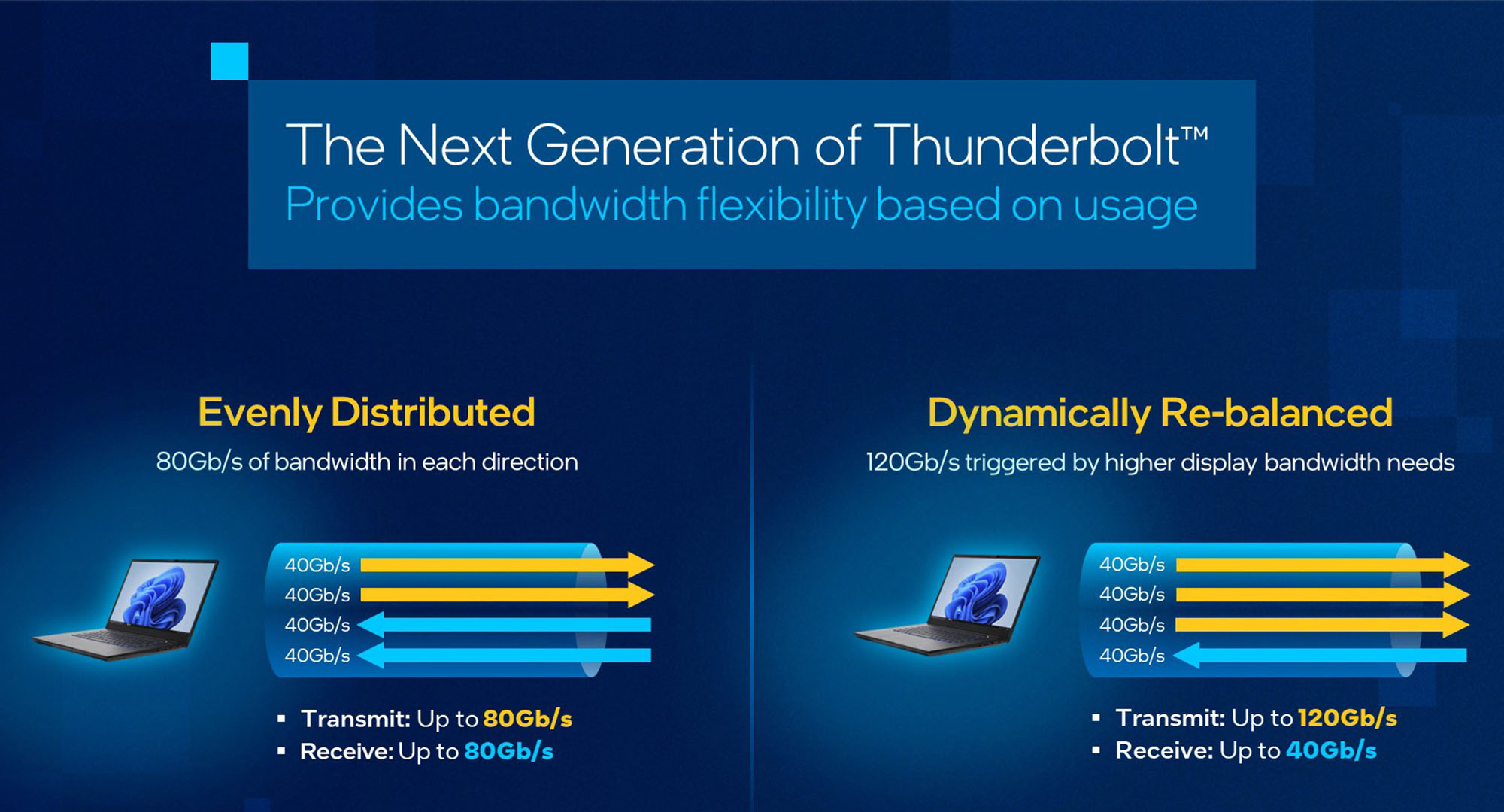News
Intel Unveils Next-Generation Thunderbolt Prototype
Intel has demonstrated an early iteration of its next-generation Thunderbolt technology, based on new USB4 v2 and DisplayPort 2.1 specs.

Intel has just released details of an early prototype of the next generation of its Thunderbolt technology. The next implementation of the port will deliver 80 Gbps of throughput, along with 120 Gbps of bandwidth, when hooked up to a display. These figures represent a massive leap in performance over the (already fast) current generation, and will be welcomed by both content creators and gamers alike.
“Thunderbolt is now the mainstream port on mobile PCs and integrated into three generations of Intel mobile CPUs. We’re very excited to lead the industry forward with the next generation of Thunderbolt built on the USB4 v2 specification,” says Jason Ziller, Client Connectivity Division, Intel.

In addition to supporting the latest USB4 standard, the next generation of Thunderbolt will feature a variety of improvements, including:
- Twice the total bandwidth of Thunderbolt 4, with triple the bandwidth for video-intensive applications.
- Support for DisplayPort 2.1.
- Twice the PCI Express data throughput for faster transfers and external GPUs.
- Ability to use existing passive cables up to 1m.
- Compatibility with previous versions of Thunderbolt, USB, and DisplayPort.
- Supported by Intel certification programs.
Also Read: Intel And Broadcom Show Off Super-Fast Wi-Fi 7 Technology
So when will gamers and content creators benefit from this new generation of Thunderbolt? Details are currently sparse, and Intel is well known for its stringent testing and certification programs, so it will be a fair while before we see major manufacturers adding updated ports to docks, laptops, and other hardware.
We’ll be sure to keep enthusiasts updated as the technology develops, but we doubt there will be further news until well into 2023.
News
Alienware Just Announced Six New Gaming Monitors
The new models include three QD-OLED and three budget-friendly QHD options, expanding the company’s lineup for all gamers.

Alienware has just updated its gaming monitor lineup with six new additions, including the highly anticipated Alienware 27 4K QD-OLED Monitor. The latest wave of releases is set to reach more gamers than ever, offering high-end QD-OLED displays alongside more budget-friendly options.
The latest displays clearly show that the company is doubling down on QD-OLED with three new models sporting the technology. A redesigned Alienware 34 Ultra-Wide QD-OLED Monitor is also making a return, further refining what is already a fan-favorite display.
A Unified Design: The AW30 Aesthetic
All six monitors feature Alienware’s new AW30 design language, first introduced at CES. The AW30 aesthetic brings a futuristic, minimalist look that unites the entire lineup under a cohesive visual identity.
Pushing QD-OLED Even Further
The refreshed Alienware 34 Ultra-Wide QD-OLED Monitor (AW3425DW) builds on its predecessor’s success with a 240Hz refresh rate (up from 175Hz) and HDMI 2.1 FRL support. It also gains G-SYNC Compatible certification alongside AMD FreeSync Premium Pro and VESA AdaptiveSync, ensuring ultra-smooth performance. With a WQHD (3440×1440) resolution and an 1800R curve, this display enhances immersion for both gaming and cinematic experiences.
For those who crave speed, the Alienware 27 280Hz QD-OLED Monitor (AW2725D) pairs a high refresh rate with QHD resolution, balancing sharp visuals with ultra-smooth gameplay. Meanwhile, the Alienware 27 4K QD-OLED Monitor (AW2725Q) delivers stunning clarity with an industry-leading pixel density of 166 PPI, making it the sharpest OLED or QD-OLED monitor available.
Also Read: Infinite Reality Acquires Napster In $207 Million Deal
Worried about OLED burn-in? Alienware’s entire QD-OLED lineup comes with a three-year limited warranty covering burn-in concerns, offering peace of mind for gamers investing in these high-end displays.
Bringing QHD To A Wider Audience
Alongside QD-OLED, Alienware is also releasing three new QHD gaming monitors aimed at more price-conscious gamers. The Alienware 34 Gaming Monitor (AW3425DWM), Alienware 32 Gaming Monitor (AW3225DM), and Alienware 27 Gaming Monitor (AW2725DM) provide a range of sizes and formats to suit different preferences:
- The Alienware 34 Gaming Monitor (AW3425DWM): An ultrawide (WQHD) option for a panoramic, immersive experience.
- The Alienware 32 Gaming Monitor (AW3225DM): A standard 16:9 panel for a traditional but expansive desktop setup.
- The Alienware 27 Gaming Monitor (AW2725DM): A 27” display offering the same performance in a more compact form factor.
All three gaming monitors feature a fast 180 Hz refresh rate, a 1ms gray-to-gray response time, and support for NVIDIA G-SYNC, AMD FreeSync, and VESA AdaptiveSync to eliminate screen tearing. Additionally, with 95% DCI-P3 color coverage and VESA DisplayHDR400 certification, these displays deliver vibrant colors and high dynamic range for lifelike visuals.



























